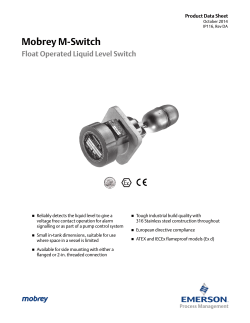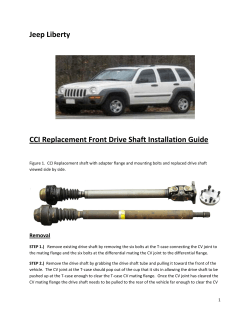
Document 238908
FL-01 2-94 WHAT IS THE PRESSURE RATING OF THAT FLANGE? What is the pressure rating of a Class of 150 flange? What is the pressure rating of a class 250 flange? The answer to both of those questions is the same. It depends! This bulletin will bring to light some of the background information concerning the actual pressure ratings of standard flanges and how it relates to the water works industry. RELATED STANDARDS Probably, the standards most often referred to concerning flanges are from the B16 Committee of the American Society of Mechanical Engineers. The most common are - ASME/ANSI B16.1-1989 “Cast Iron Pipe Flanges and Flanged Fittings” - ASME/ANSI B16.5-1988 “Pipe Flanges and Flanged Fittings” - ASME/ANSI B16.42-1987 “Ductile Iron Pipe Flanges and Flanged Fittings” These standards cover grey iron, ductile iron, various steels, and nickel alloy flanges with classifications from Class 125 to Class 2500. Some of the American Water Works Association standards that deal with flanges are - ANSI/AWWA C110/A21.10-87 “American National Standard for Ductile Iron and Gray Iron Fittings, 3 In. Through 48 In., for Water and Other Liquids” - ANSI/AWWA C115/A21.15-88 “American National Standard for Flanged Ductile-Iron Pipe With Threaded Flanges” - ANSI/AWWA C207-86 “Steel Pipe Flanges for Waterworks Service-Sizes 4 In. Through 144 In.” The primary objective of these standards, ASME and AWWA, is to describe flanges and flange materials in a manner that allows for compatibility with other flanges. The “125 pound” or the “150 pound” flanges are used most frequently. Those flange dimensions are the same as those referenced to in AWWA C110 and AWWA C115. BACKGROUND The following is a condensed time line of some of the events shaping the formation of the B16 standards that are in use today. This information is taken from the forewords of the standards listed previously. 1894-- A standard flange template was adopted by ASME for low pressure applications. 1901-- A manufacturer’s standard was established for the 250 pound flange pattern. 1914-- ASME and various manufacturers developed a compromise standard for standard steam pressures of 125 psi (345 degrees F) and 250 psi (400 degrees F). 1918-- Flange patterns were standardized for 50 pound steam ratings as well as 800, 1200, and 3000 pound hydraulic flanges. 1932-- The pressure ratings for the 250 lb. and 1350 lb. flanges were increased. 1936-- Pressure-Temperature ratings were established for all flanges. 1942-- Pressure-Temperature ratings were revised. 1957-- With the introduction of ductile iron, confusion arose over pressure-temperature ratings relative to grey iron and steel. 1973-- The flange designations were changed from “pound” to “Class”. The 150 pound flange became the Class 150 flange, etc. 1975-- Higher grades of iron necessitated the establishment of a second set of ratings for smaller flange sizes. 1979-- B16.42 was accepted. 1981-- More materials were added to B16.5. It can be seen from the sequence of events over the past century that flange ratings have developed over a period of time where materials have improved and large amounts of data have been taken. The standardization of the flange and flange materials has been a long, steady process that will continue to change as materials and techniques evolve. PRESSURE RATINGS The B16 standards deal with flanges made from many different materials, that will be used to transmit many types of materials, at many different temperatures. As a result the pressure ratings change as the temperature changes. For example: Class 150 Flange Template B16 Pressure Ratings Spec. Material Press. Rat. Temp. (F) (psi) B16.5 Var. Carbon Steels 235100 290 B16.5 Var. Nickel Alloys 90-290 100 B16.5 Var. Carbon Steels 140 600 B16.5 Var. Nickel Alloys 85-140 600 B16.42 Ductile Iron 250 100 B16.42 Ductile Iron 140 600 In addition to the pressure rating listed in Section 2.1 of B16.42-1987 there is an equation in Annex A that can be used to derive the ambient pressure ratings for Class 150 and Class 300 flanges. With a minimum yield strength of 42,000 psi for ductile iron, the ambient temperature pressure rating for a Class 150 flange comes out to be 331 psi. It is possible, therefore, to get two different pressure ratings from the same standard. The information from the B16 standards does not begin to address other flanging materials that are on the market. You can obtain flanges with Class 150 templates that are made of PVC, PE and many special non-metallic materials. And what about copper, brass, and special alloy steels? All of this confusing information is an indirect answer to the two questions presented at the beginning of this bulletin. There are many factors that affect the rated pressure of Class 150 and Class 300 flanges. In most industrial applications, it depends on the flange material and the operating temperature. By the way Class 125 and Class 150 flanges have the same flange template. In like manner, Class 250 and Class 300 flanges have the same flange template. APPLICATION In the waterworks industry things are simpler because the variable are narrowly defined. Most systems will operate with an ambient temperature of less than 100 degrees F. and the transmitted media will generally be water or water based. According to AWWA C110 the pressure rating for ductile iron, flanged fittings is 250 psi in all sizes. The proof test for these fittings is a hydrostatic pressure test to three times the rated pressure. It is interesting that, in the same standard, mechanical joint fittings up through the twenty-four inch size with the same wall thickness as the flanged fittings, have a pressure rating of 350 psi with a three to one safety factor. This indicates that there is not a problem with the strength of the standard flanged fitting that would inhibit its ability to withstand extreme pressures. There are, however, limitations with the ability of the flange to seal at high pressures. The standard flat faced gasket with the standard flange is very difficult to assemble and obtain a good seal at higher pressures. There are, however, gaskets and products on the market to overcome the sealing difficulty. EBAA Iron produces two products that employ the standard Class 150 flange template. The FLEXTEND® family and the 2100 series MEGAFLANGE® flange adapter. These products have pressure ratings as high as 350 psi with safety factors from three to one to five to one. This is possible because we use 0ring seals at the flange face. EBAA uses a five to one safety factor on a pressure rating of 350 psi to mean that the device can physically withstand the forces at 1750 psi and provide a leak free seal at the same time. CONCLUSION There are more factors affecting the pressure rating of a flange than its stated class. There are differences in material, differences in sealing methods, and differences in operating temperatures. Since most waterworks applications operate at ambient temperatures, the various temperature-pressure ratings in the B16 standards don’t apply. The pressure ratings listed in C110 and C115 are generally effective. The pressure rating for the C110 fittings and C115 flanged pipe is 250 psi with a three to one safety factor. If a product from EBAA Iron has a pressure rating of 350 psi with a three to one safety factor, the flange and the seal provided are included in that rating. The fact that these have Class 150 flange templates does not limit their performance capability to 150 psi or even 250 psi. EBAA IRON – Your Connection to the Future.™ FL-01 2-94 This is one of a series of CONNECTIONS reports addressing design and application subjects. If you would like copies of other reports or a listing of available reports contact your EBAA Iron representative or call EBAA Iron Sales at (800) 433-1716 or fax (254) 629-8931. EBAA’s engineering group can be reached at (800) 633-9190 or fax (254) 629-2079. Copyright © 1994 EBAA IRON SALES, INC. P.O. Box 857, Eastland, Texas 76448 USA PHONE: (254) 629-1731 CALL TOLL FREE: 800-433-1716 TELEFAX: (254) 629-8931 http://www.ebaa.com contact@ebaa.com
© Copyright 2025












